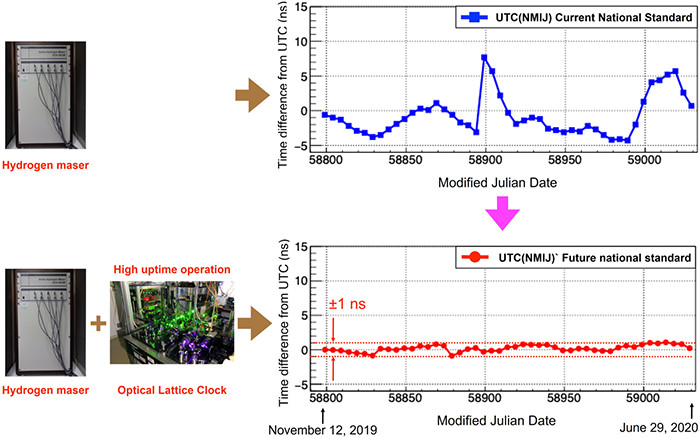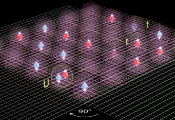Generation of the World's Top Level Time Scale with a High Uptime Optical Lattice Clock
July 4, 2024 -- Currently, the second is defined by a microwave frequency (approximately 9.2 GHz), which resonates with cesium atoms, with an accuracy of 15 to 16 orders of magnitude (a deviation of only 1 second every 30 to 300 million years). Optical clocks such as optical lattice clocks and optical ion clocks using optical frequencies higher than the microwave frequency (400-500 THz) are expected to improve the accuracy of time by another 1 to 2 orders of magnitude and are considered as promising candidates for the redefinition of the second. To redefine the second, many challenges remain, such as ensuring that the new definition using the optical frequency is accurate and realized robustly over a longer period compared with the current definition using the microwave frequency, and that continuity with the current definition is guaranteed. One of the conditions that are desired to be achieved for the redefinition of the second is the generation of a highly accurate and stable time scale over a long period by adjusting the frequency of a hydrogen maser atomic clock, which can be operated continuously, based on an optical clock.

Since the frequencies of hydrogen maser atomic clocks change gradually, they need to be adjusted regularyregularly . Therefore, the time scale is generated by manually adjusting the frequency of the hydrogen maser atomic clock based on the time difference from UTC obtained by remote comparison with a satellite link. On the other hand, it is expected that adjusting the frequency of hydrogen maser atomic clock using an optical clock will generate a time scale with higher accuracy than the current one, and so research to incorporate an optical clock into a time scale is being conducted in many countries. However, optical clocks are extremely complex devices that require manual fine-tuning, and many research institutes can only operate them at low uptimes, making it impossible to completely suppress the frequency fluctuations of hydrogen maser atomic clocks during the shutdown periods of the optical clocks.
Researchers at AIST, in collaboration with researchers at Yokohama National University, have succeeded in generating a highly accurate time scale for 230 consecutive days by using an optical lattice clock. Details of this technology have been published in Physical Review Applied on June 7, 2024 (EST).
Currently, a redefinition of the second is being discussed so that the optical frequency obtained using an optical clock will be used as the standard. Once the second is redefined, it is expected that a "graduated scale" tens of thousands of times finer than the current definition will be established, and that highly accurate time and frequency can be supplied to society. Many issues remain to be addressed in order to redefine the second, such as ensuring that the new definition is accurate and realized robustly over a long period compared with the current definition. Among them, the generation of a highly accurate and stable time scale by adjusting the frequency of an atomic clock based on an optical clock is considered as one of the conditions that are desired to be achieved for the redefinition of the second, and so research to incorporate an optical clock into a time scale is underway in many countries. AIST has been generating a time scale by manually adjusting the frequency of a hydrogen maser atomic clock, which is an atomic clock capable of continuous operation, but an even more accurate time scale can be expected to be generated by using an optical lattice clock. However, it has been difficult to accurately adjust the frequency of the atomic clock during the shutdown period of the optical lattice clock because the optical lattice clock could only be operated at a low uptime.
Using previously obtained data from an optical lattice clock that had been successfully operated at high uptime, the frequency of the hydrogen maser atomic clock was adjusted in a postprocessing analysis to generate a time scale based on the optical lattice clock. This time scale achieved the world's highest level of synchronization accuracy of within ±1 ns (one billionth of a second) from UTC, the international time standard, over a 230-day period. This achievement is expected to accelerate the consideration of the redefinition of the second.




































